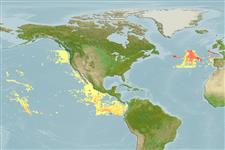>
Anguilliformes (Eels and morays) >
Synaphobranchidae (Cutthroat eels) > Ilyophinae
Etymology: Ilyophis: Greek, ilyos, -ou = cave + Greek, ophis = serpent (Ref. 45335).
Eponymy: Arx is Latin for castle, alluding to Dr Peter Henry John Castle (1934–1999), who “laid the foundations of modern work on synaphobranchid eels”. (See Castle) (Ref. 128868), visit book page.
Environment: milieu / climate zone / depth range / distribution range
Ecologia
marinhas batidemersal; intervalo de profundidade 2375 - 4157 m (Ref. 132084). Deep-water; 30°N - 15°S (Ref. 132084)
East Central Pacific: from the Nazca Ridge off central Peru to seamounts northwest off Hawaii.
Comprimento de primeira maturação / Tamanho / Peso / Idade
Maturity: Lm ?, range 24 - ? cm
Max length : 61.0 cm TL macho/indeterminado; (Ref. 132084)
Descrição suscinta
Chaves de identificação | Morfologia | Morfometria
Raios dorsais (total) : 309 - 322; Raios anais : 235 - 261; Vértebras: 131 - 135. This species is distinguished by the following characters. body no dcales; trunk relatively long
(about 21-29% of TL); dorsal-fin origin (DFO) above the posterior third of pectoral fin; gape of mouth moderate, extending to near rear margin of eye; teeth not compound; intermaxillary teeth conical with approximately 16-24 teeth in the tooth patch, inner teeth on the patch nearly twice as large as the outer teeth; vomerine teeth contiguous with intermaxillary teeth with approximately 25-30 teeth, irregularly biserial to triserial anteriorly and uniserial posteriorly; both the intermaxillary and vomerine teeth set in beds of papillose tissue; maxillary teeth small, set in irregular rows, 3 rows anteriorly to 6 rows posteriorly; dentary teeth similar to maxillary teeth except they are slightly larger and more uniform in size anteriorly; lateral line short, confined to the anterior half of body (ca. 35-45% of TL); cephalic lateralis pores with supraorbital (SO) 3, infraorbital (IO) 5 (including adnasal, AD), preoperculomandibular (POM) 6-10; total vertebrae 129-136 (Ref. 132084).
This species may be a specialist of seamounts, ridges and island slopes, suggesting that it may only be found associated with rough topographies (Ref. 132084).
Ciclo de vida ou comportamento de acasalamento
Maturidade | Reprodução | Desova | Ovos | Fecundidade | Larvas
Tighe, K.A., D.G. Smith, N.R. Merrett, B.W. Frable and U. Zajonz, 2024. Redescription of the eel Ilyophis arx Robins, 1976 (Anguilliformes:
Synaphobranchidae: Ilyophinae) with a description of a new species of Ilyophis,
and a taxonomic synopsis of the Ilyophinae. Zootaxa 5506(1):35-57. (Ref. 132084)
Status na Lista Vermelha da UICN (Ref. 130435: Version 2024-1)
Ameaça para os humanos
Harmless
Uso pelos humanos
Pescarias: sem interesse
Ferramentas
Relatórios especiais
Baixar XML
Fontes da internet
Estimates based on models
Preferred temperature (Ref.
123201): 2 - 3.3, mean 2.7 °C (based on 14 cells).
Índice de diversidade filogenética (Ref.
82804): PD
50 = 0.5156 [Uniqueness, from 0.5 = low to 2.0 = high].
Bayesian length-weight: a=0.00102 (0.00046 - 0.00225), b=3.06 (2.88 - 3.24), in cm total length, based on all LWR estimates for this body shape (Ref.
93245).
Nível Trófico (Ref.
69278): 4.0 ±0.4 se; based on size and trophs of closest relatives
Resiliência (Ref.
120179): médio(a), tempo mínimo de duplicação da população 1,4 - 4,4 anos (Fec = 1,979).
Fishing Vulnerability (Ref.
59153): Moderate vulnerability (44 of 100).
